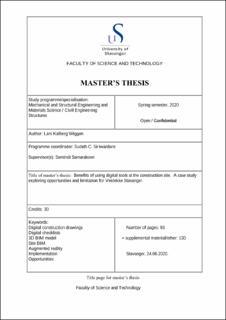| dc.contributor.advisor | Samarakoon, Samindi | |
| dc.contributor.author | Wiggen, Lars Kalberg | |
| dc.date.accessioned | 2020-09-25T12:02:20Z | |
| dc.date.available | 2020-09-25T12:02:20Z | |
| dc.date.issued | 2020-07-25 | |
| dc.identifier.uri | https://hdl.handle.net/11250/2679732 | |
| dc.description | Master's thesis in Structural engineering | en_US |
| dc.description.abstract | The construction industry is behind the other industries in mainland Norway in terms of productivity and the use of digital tools. Veidekke wants to become in the forefront when it comes to using digital tools and digitalization at the construction site.
This thesis was written in collaboration with Veidekke Stavanger and describes how Veidekke Stavanger has started up with digitalization at the construction site by introducing digital building drawings and digital checklists. A case study has been conducted where three projects have been examined to see how Veidekke implement digital supporting tools and what advantages and disadvantages this brings to Veidekke and the work force. The problem is defined as.
How can Veidekke Stavanger achieve a successful implementation of digital tools at the construction site?
The research work has been carried out based on literature study, interviews, and a survey. The literature study focused on relevant technology to be utilized at the construction site. This being both software solutions such as BIM, Dalux and SharePoint as well as relevant hardware such as smartphone, tablets, and BIM kiosk. The interviews were conducted with the construction site manager, concrete foreman and lead shutter for the three different projects. A survey was also conducted by 26 construction workers on the three different projects.
This study focusses on the implementation and use of digital building drawings and digital checklists. Elements for successful implementation and identified opportunities for improvement within digital solutions are discussed and compared within the three projects.
Findings from this thesis is that all three projects have implemented digital checklist and are satisfied with the transition. One project has implemented digital drawings at the construction site, and this have been executed without major complications.
The thesis suggests specific actions to enable Veidekke Stavanger to reach their short-term goals within digitalization. The main conclusion being that the top-level managerial decision needs to be implemented in the lowest level in the organization. There exist no practical barriers for a successful implementation. | en_US |
| dc.language.iso | eng | en_US |
| dc.publisher | University of Stavanger, Norway | en_US |
| dc.relation.ispartofseries | Masteroppgave/UIS-TN-IMBM/2020; | |
| dc.subject | materialteknologi | en_US |
| dc.subject | byggkonstruksjon | en_US |
| dc.subject | 3D BIM model | en_US |
| dc.subject | Site BIM | en_US |
| dc.subject | digital construction drawings | en_US |
| dc.subject | digital checklists | en_US |
| dc.subject | augmented reality | en_US |
| dc.subject | implementation | en_US |
| dc.title | Benefits of using digital tools at the construction site. A case study exploring opportunities and limitation for Veidekke Stavanger | en_US |
| dc.type | Master thesis | en_US |
| dc.subject.nsi | VDP::Teknologi: 500::Materialteknologi: 520 | en_US |
